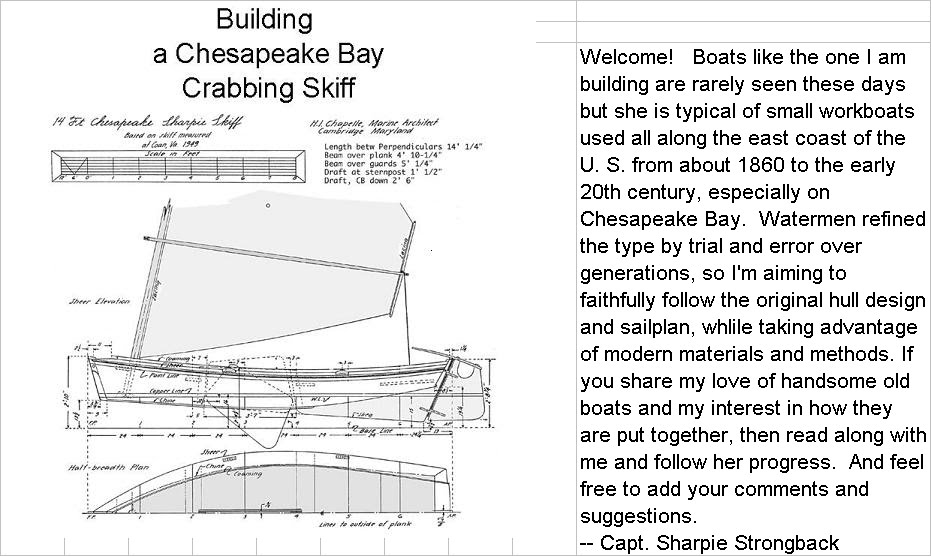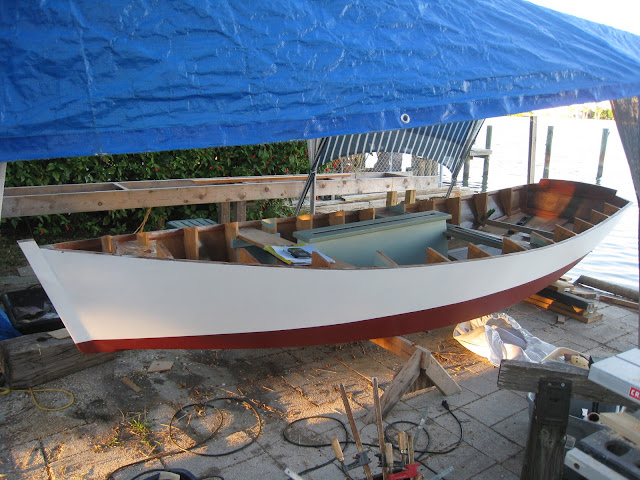After a ten-day trip out of town, I was able to resume boatbuilding this week.
The bottom and topsides are done, except of course for a little touchup when everything else is complete. On Tuesday, with the help of Mrs. Strongback, I turned the boat over to work on the inside, but got no other work done. The waterline makes it easier to see now how the boat will look in the water.
On Wednesday I got three projects moving along.
After having fiberglassed the topsides, not much excess fabric and epoxy remained along the sheer because I had sliced it off with a razor before it hardened, but what there was I sanded off, leaving the sheer smooth.
I carefully drilled a 1/2" hole through the stem for a painter line, but also low enough to provide a good point from which to tow the boat, if I ever do that. The next time I seal something with epoxy, I'll swab that hole with sealer also.
Before leaving on the latest trip, I had glued and screwed the rudder assembly together. On Wednesday I cut out the finished edge lines with a jigsaw, and tapered the trailing edge, using a power plane and belt sander.
Today, Thursday, I spent a crazy amount of time calculating and measuring for placement of a couple of details. After getting the boat level fore and aft, I started placement of the supports for the stern sheets, the seat at the stern. According to the plans, the sternsheets are not level, but rather slope down from the stern at 3 degrees.
One unusual tool I have is a brass adjustable level which can be set to any angle desired. I had it for years as a desk ornament when I was gainfully employed, but never knew its history or purpose until a customer identified it as a WWII-era artillery clinometer. He explained that it was set for whatever elevation angle was called for by the gunnery officer, and held on the gun's barrel while the gun was raised or lowered until the "clino" showed level. Then it was taken away before the gun was fired, lest it be shaken and broken.
There are not many applications for a level which you deliberately set to an angle other than level, but it was just what I needed to measure the 3 degree slope and mark where the forward support for the sternsheets should be attached to the frames on each side. I dressed a piece of pine with the thickness planer, cut it to the right angle for the flare and narrowing of the sides, and gradually cut it down until it fit against the sides, right at the desired height. I clamped the piece in place.
The other angle I fussed over was the placement of the mast step. Once permanently installed, it will not be adustable, so I will screw it down temporarily at my best guess of the right place, and maybe adjust it after the boat is rigged. The mast is to rake aft at 12.25 degrees, according to the plans. So I measured down from the mast thwart to the bottom at that angle, over and over, and marked where the step should initially be. It turns out the step needs to be farther forward that the narrowing of the bow permits, so I trimmed off the forward corners to give it more room.
Here's a picture of my small gains of the last two days. Yes, I know, if I don't pick up the pace I'll grow old and die before the boat is finished:
Thursday, November 18, 2010
Subscribe to:
Post Comments (Atom)



No comments:
Post a Comment